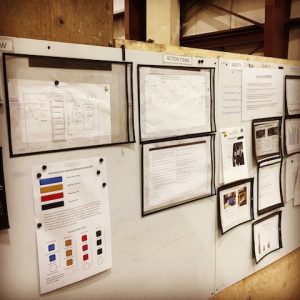Kaizen Part 3: Finding the Bottleneck
We know you’ve been following along with our last two installments of Kaizen blogs, but let’s recap. In Part 1, we introduced the idea of Kaizen, lean manufacturing, and gave an overview of what we learned from the Toyota production system. We talked about the benefits on the pallet we designed especially for our Model 6000 Dinghy Hauler Davit. Benefits including improved production flow, decreased packaging times, and saved costs for everyone, and reduced waste destined for our oceans and landfills.
In Part 2, we took a closer look at how we create and maintain flow in our manufacturing process. This article examined improvements to our two bin system; reducing lead times and decreasing costs resulting in savings passed onto our customers. The Model 4100 High Thrust Outboard Motor Bracket makes a great example of all the benefits of Kaizen, highlighting how we reduced lead times from 6 weeks to 2 weeks.
In Part 3, we will focus our attention on how to find production bottlenecks and discuss the downside of cost accounting in the manufacturing thought process. This section will be beneficial to you as you make decisions for your businesses, life, and how you direct your spending.
What is a Bottleneck?
So, what is a bottleneck? In short, a bottleneck is the slowest part of the assembly line. Like the weakest link in a chain, it dictates the speed capacity of the entire manufacturing process. Locating and working through bottlenecks is imperative to lean improvement. It is not as easy to spot as you might assume. Many hours of data analysis are often needed to determine where the bottleneck lies. Without doing this research, predicting lead and delivery times is a shot in the dark.

Enter the Theory of Constraints! TOC focuses on three key elements; 1) throughput; 2) operating expense; and 3) inventory. What makes TOC different from traditional cost manufacturing approach, is that inventory is an expense until it’s switched into sales (defined as throughput). In traditional manufacturing, the inventory is seen as money in the bank because it has the potential to be sold. This is great for banks and shareholders, but not good for the company as an entirety because it does nothing to ensure costs are kept low. Traditional cost manufacturing alters the perceived value of the company and removes the motivation to work towards constant improvement; one of the founding principles of Kaizen.
Some of you may be thinking, “but it takes six months to get our parts – we need to stock them!” To illuminate the process, let us plan a fun family camping trip with the potential to fall into chaos. This family is large, so they set out in 4 separate cars, distributing the supplies amongst themselves. The cars represent the different manufacturing cells. The first 3 cars are newer and designed to carry more weight. Bringing up the rear is Grandma’s much loved 1970’s station wagon which, while charming and spacious, lacks the speed and fuel efficiency of the others. Now, imagine you give Grandma all the essentials, like tents, food, cooking equipment, and sleeping bags. You’ll quickly see she falls behind, slowing down the whole group. What use are kayaks and paddle boards without food and shelter? The person tasked with coordinating this trip will undoubtedly be spending a lot of time ensuring that the group waits for Grandma to the frustration of others who want to get out there and start their vacation!
Determined to make use of her spacious vehicle, Grandma had loaded it with equipment making it heavier and slower. In this scenario, your bottleneck is Grandma’s station wagon. After identifying the issue, you call everyone over to a rest stop and redistribute equipment. The more powerful vehicles are given heavier loads AND told they cannot pass anyone. If they do want to pass someone, they will have to take on even more weight. Grandma is then put in front of the group. Now, Grandma sets the speed of the group and, with that, you are now able to more accurately predict the speed of the entire group.
Why Kaizen Works
While individual vehicles may be slowed by this process, the group as a whole increases their speed. Rather than everyone stopping and starting, a smooth steady flow is achieved. Their arrival time (lead time) is predictable and synchronized.
At first, it may appear to be counterintuitive to dedicate more resources to the least efficient area of your manufacturing process. Some may even dispute you canceling work orders for non-sale items and decreasing your work in progress. But remember, the idea is to get everyone to the end goal as quickly as possible. The result will add tremendous value to your operations and encourage teamwork across manufacturing cells.
A lot of the ideas outlined in this blog series are new and exciting and we encourage you to ask questions and comment on how you think they might impact you personally or professionally. We even have an expert on staff who is happy to answer questions or visit your facility. Contact Greg at adventuremarinegreg@gmail.com for more information.
From the Adventure Marine family,
Happy boating!